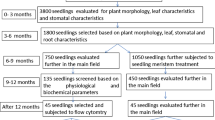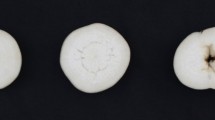Abstract
Polyploid plants have been induced in different Asparagus officinalis L. breeding programs in order to obtain plants with improved agronomical traits, such as large spear diameter or segregation ratios with a higher number of males. The polyploidization methods can produce somaclonal variation in the polyploid plants obtained and, therefore, unwanted changes in the agronomical traits of the initial elite plants. We used two different polyploidization methods to induce polyploid plants from diploid genotypes of commercial varieties and tetraploid genotypes of the Spanish landrace “Morado de Huétor”. The first method was the culture of rhizome buds in the medium ARBM-3 (Asparagus Rhizome Bud Medium), supplemented with different concentrations of colchicine (0.1–0.75 g l−1) for 10 and 20 days. The best polyploidization rate obtained was 25 % (0.5 g l−1 colchicine for 10 days). The second method was the regeneration of polyploid plants from callus culture, resulting in a polyploidization rate of 40 and 12.5 % for the diploid genotype CM077 and the tetraploid genotype HT156, respectively. Additionally, we have developed a new protocol to separate the mixoploids generated into their different genetic components, obtaining plants with a unique ploidy level. EST-SSRs markers were employed to analyze the genetic stability of polyploidy plants. Somaclonal variation was not detected for polyploidy plants obtained through the culture of rhizome bud explants. Therefore, these polyploid plants should maintain the agronomical traits of the initial elite plants. However, somaclonal variation was detected in the polyploid plants regenerated from callus culture.






Similar content being viewed by others
References
Abu-Qaoud H, Skirvin RM, Chevreau E (1990) In vitro separation of chimeral pears into their component genotypes. Euphytica 48:189–196
Ahmed EU, Hayashi T, Yazawa S (2004) Auxins increase the occurrence of leaf-colour variants in Caladium regenerated from leaf explants. Sci Hortic 100:153–159
Aina O, Quesenberry K, Gallo M (2012) In vitro induction of tetraploids in Arachis paraguariensis. Plant Cell Tiss Organ Cult 111:231–238
Bairu MW, Aremu AO, Van Staden J (2011) Somaclonal variation in plants: causes and detection methods. Plant Growth Regul 63:147–173
Braak JP, Zeilinga AE (1957) Production of a colchicine-induced tetraploid asparagus. Euphytica 6(3):201–272
Camadro EL (1992) Cytological mechanism of 2n microspore formation in garden asparagus. HortScience 27:831–832
Camadro EL (1994) Second meiotic division restitution (SDR) 2n pollen formation in diploid and hexaploid species of asparagus. Genet Resour Crop Evol 41:1–7
Carmona-Martin E, Regalado JJ, Raghavan R, Encina CL (2014a) In vitro induction of autooctoploid asparagus genotypes. Plant Cell Tiss Organ Cult. doi:10.1007/s11240-014-0680-4
Carmona-Martin E, Regalado JJ, Padilla IMG, Westendrop N, Encina CL (2014b) A new efficient micropropagation method and its breeding applications in Asparagus genera. Plant Cell Tiss Organ Cult 119:479–488
Caruso M, Federici CT, Roose ML (2008) EST-SSR markers for asparagus genetic diversity evaluation and cultivar identification. Mol Breed 21:195–204
Castro P, Gil J, Cabrera A, Moreno R (2013) Assesment of genetic diversity and phylogenetic relationship in Asparagus species related to Asparagus officinalis. Genet Resour Crop Evol 60:1275–1288
Castro P, Rubio J, Gil J, Moreno R (2014) Introgression of new germplasm in current diploid cultivars of garden asparagus from a tetraploid Spanish lancrace “Morado de Huétor”. Sci Hortic 168:157–160
Corriols L, Dore C, Rameau C (1990) Commercial reléase in France of Andreas, the 1st asparagus all-male F1 hybrid. Acta Hortic 271:249–252
CESURCA, CRDE Espárrago de Huétor-Tájar, González Fernández JE, Encina CL, Cermeño Sacristán P, Espejo Calvo JA, Gil Ligero J, Moreno Pinel R, Calado Moreno S (2012) Registro de la variedad octoploide de espárrago HT-801 (O.E.V.V. 20070317, O.E.V.V. 20074745). Prioridad: 11/10/2007. Concesión: 03/10/2012. Numero de concesión: ES2349102. España
Currais L, Loureiro J, Santos C, Canhoto JM (2013) Ploidy stability in embryogenic cultures and regenerated plantlets of tamarillo. Plant Cell Tiss Organ Cult 114:149–159
Debnath SC (2011) Adventitious shoot regeneration in a bioreactor system and EST-PCR based clonal fidelity in lowbush blueberry (Vaccinium angustifolium Ait.). Sci Hortic 128:124–130
Dhooghe E, Denis S, Eeckhaut T, Reheul D, Van Labeke MC (2009) In vitro induction of tetraploids in ornamental Ranunculus. Euphytica 168:33–40
Dhooghe E, Van Laere K, Eeckhaut T, Leus L, Van Huylenbroeck J (2011) Mitotic chromosome doubling of plant tissue in vitro. Plant Cell Tiss Organ Cult 104:359–373
Ellison JH (1986) Asparagus breeding. In: Breeding vegetable crops, AVI Publishing Co, Westport, pp 521–569
Falavigna A, Alberti P, Casali PE, Toppino L, Huaisong W, Mennella G (2008) Interspecific hybridization for Asparagus breeding in Italy. Acta Hortic 776:291–298
Flory WS (1932) Genetic and cytological investigations on Asparagus officinalis L. Genet Princenton 17:432–467
Gantait S, Mandal N, Bhattacharyya S, Kanti Das P (2011) Induction and identification of tetraploids using in vitro colchicine treatment of Gerbera jamesonii Bolus cv. Sciella. Plant Cell Tiss Organ Cult 106:485–493
Gao SL, Zhu DN, Cai ZH, Xu DR (1996) Autotetraploid plants from colchicine-treated bud culture of Salvia miltiorrhiza Bge. Plant Cell Tiss Organ Cult 47:73–77
Gao DY, Vallejo V, He B, Gai YC, Sun LH (2009) Detection of DNA changes in somaclonal mutants of rice using SSR markers and transposon display. Plant Cell Tissue Organ Cult 98:187–196
Gesteira AS, Otoni WC, Barros EG, Moreira MA (2002) RAPD based detection of genomic instability in soybean plants derived from somatic embryogenesis. Plant Breed 121:269–271
Gomes SSL, Saldanha CW, Neves CS, Trevizani M, Raposo NRB, Notini MM, de Oliveira Santos M, Campos JMS, Otoni WC, Viccini L (2014) Karyotype, genome size, and in vitro chromosome doubling of Pfaffia glomerata (Spreng.) Pedersen. Plant Cell Tiss Organ Cult 118:45–56
Jin S, Mushke R, Zhu H, Tu L, Lin Z, Zhang Y, Zhang X (2008) Detection of somaclonal variation of cotton (Gossypium hirsutum) using cytogenetics, flow cytometry and molecular markers. Plant Cell Rep 27:1303–1316
Johnson RT (1980) Gamma irradiation and in vitro induced separation of chimeral genotypes in carnation. HortScience 15:605–606
Kadota M, Niimi Y (2002) In vitro induction of tetraploid plants from a diploid Japanese pear cultivar (Pyrus pyrifolia N. cv. Hosui). Plant Cell Rep 21:282–286
Khlestkina E, Röder M, Pshenichnikova T, Börner A (2010) Functional diversity at the Rc (red coleoptile) gene in bread wheat. Mol Breed 25:125–132
Koornneef M, Van Diepen JAM, Hanhart CJ, Kieboom-de Waart AC, Martinelli L, Schoenmakers HCH, Wijbrandi J (1989) Chromosomal instability in cell and tissue cultures of tomato haploids and diploids. Euphytica 43:179–186
Kunitake H, Nakashima T, Mori K, Tanaka M (1998) Somaclonal and chromosomal effects of genotype, ploidy and culture duration in Asparagus officinalis L. Euphytica 102:309–316
López-Anido F, Cointry E (2008) Asparagus. In: Prohens J, Nuez F (eds) Vegetables II: fabaceae, liliaceae, umbelliferae, and solanaceae. Handbook of plant breeding. Springer, New York, pp 87–119
Mac Key J (1987) Implications of polyploidy breeding. Biologisches Zentralblatt 106:257–266
Marcotrigiano M (1986) Origin of adventitious shoots regenerated from cultures tobacco leaf tissue. Am J Bot 73:1541–1547
Marum L, Rocheta M, Maroco J, Oliveira M, Miguel C (2009) Analysis of genetic stability at SSR loci during somatic embryogenesis in maritime pine (Pinus pinaster). Plant Cell Rep 28:673–682
Mc Pheeters K, Skirvin RM (1983) Histogenic layer manipulation in chimeral ‘Thornless Evergreen’ trailing blackberry. Euphytica 32:351–360
Moreno R, Espejo JA, Cabrera A, Millan T, Gil J (2006) Ploidic and molecular analysis of ‘Morado de Huetor’ asparagus (Asparagus officinalis L.) population; a Spanish tetraploid landrace. Genet Resour Crop Evol 53:729–736
Moreno R, Espejo JA, Moreno MT, Gil J (2008a) Collection and conservation of “Morado de Huetor” Spanish tetraploid asparagus landrace. Genet Resour Crop Evol 55:773–777
Moreno R, Espejo JA, Cabrera A, Gil J (2008b) Origin of tetraploid cultivated asparagus landraces inferred from nuclear ribosomal DNA internal transcribed spacers polymorphisms. Ann Appl Biol 153:233–241
Moreno R, Espejo JA, Gil J (2010) Development of triploid hybrids in asparagus breeding employing a tetraploid landrace. Euphytica 173:369–375
Murashige T, Skoog F (1962) A revised medium for rapid growth and bioassays with tobacco tissue culture. Physiol Plant 15:473–497
Nehra NS, Kartha KK, Stushnott C, Giles KL (1992) The influence of plant growth regulator concentrations and callus age on somaclonal variation in callus culture regenerants of strawberry. Plant Cell Tiss Organ Cult 29:257–268
Ochatt SJ, Patat-Ochatt EM, Moessner A (2011) Ploidy level determination within the context of in vitro breeding. Plant Cell Tiss Organ Cult 104:329–341
Odake Y, Udagawa A, Saga H, Mii M (1993) Somatic embryogenesis of tetraploid plants from internodal segments of a diploid cultivar of Asparagus officinalis L. grown in liquid culture. Plant Sci 94:173–177
Ozaki Y, Narikiyo K, Fujita C, Okubo H (2004) Ploidy variation of progenies from intra- and inter-ploidy crosseswith regard to trisomic production in asparagus (Asparagus officinalis L.). Sex Plant Reprod 17:157–164
Pedrol J, Regalado JJ, López-Encina C (2013) Asparagus L.: Asparagus macrorrhizus (Pedrol, JJ Regalado & Lopez-Encina), sp.nov. In: Rico E, Crespo MB, Quintanar A, Herrero A, Aedo C (eds) Flora Ibérica, vol XX. Madrid, pp 117–119
Pontaroli AC, Camadro EL (2005) Somaclonal variation in Asparagus officinalis plants regenerated by organogenesis from long-term callus cultures. Genet Mol Biol 28:423–430
Rahman MH, Rajora OP (2001) Microsatellite DNA somaclonal variation in micropropagated trembling aspen (Populus tremuloides). Plant Cell Rep 20:531–536
Raimondi JP, Camadro EL, Masuelli RW (2001) Assessment of somaclonal variation in asparagus by RAPD fingerprinting and cytogenetic analyses. Sci Hortic 90:19–29
Rani V, Raina S (2000) Genetic fidelity of organized meristem derived micropropagated plants: a critical reappraisal. In Vitro Cell Dev-Plant 36:319–330
Rasband WS (1997–2013) ImageJ, U. S. National Institutes of Health, Bethesda, Maryland, USA, http://imagej.nih.gov/ij/
Rêgo MM, Rêgo ER, Bruckner CH, Finger FL, Otoni WC (2011) In vitro induction of autotetraploids from diploid yellow passion fruit mediated by colchicine and oryzalin. Plant Cell Tiss Organ Cult 107:451–459
Roy AT, Leggett G, Koutoulis A (2001) In vitro tetraploid induction and generation of tetraploids from mixoploids in hop (Humulus lupulus L.). Plant Cell Rep 20:489–495
Sharma S, Bryan G, Winfield M, Millam S (2007) Stability of potato (Solanum tuberosum L.) plants regenerated via somatic embryos, axillary bud proliferated shoots, microtubers and true potato seeds: a comparative phenotypic, cytogenetic and molecular assessment. Planta 226:1449–1458
Singh R, Srivastava S, Singh S, Sharma M, Mohopatra T, Singh N (2008) Identification of new microsatellite DNA markers for sugar and related traits in sugarcane. Sugar Tech 10:327–333
Skiebe K, Stein M, Gottwald J, Wolterstorff B (1991) Breeding of polyploid asparagus (Asparagus officinalis L.). Plant Breed 106:99–106
Snow R (1963) Alcoholic-hydrochloric acid carmine as a stain of chromosomes in squash preparations. Stain Technol 38:9–13
Torres AM, Weeden NF, Martín A (1993) Linkage among isozyme, RFLP and RAPD markers in Vicia faba. Theor Appl Genet 85:937–945
Wang RR, Gao XX, Chen L, Huo LQ, Li MF, Wang QC (2014) Shoot recovery and genetic integrity of Chrysanthemum morifolium shoot tips following cryopreservation by droplet-vitrification. Sci Hortic 176:330–339
Zhang Z, Dai H, Xiao M, Liu X (2008) In vitro induction of tetraploids in Phlox subulata L. Euphytica 159:59–65
Zhang M, Wang H, Dong Z, Qi B, Xu K, Liu B (2010) Tissue culture induced variation at simple sequence repeats in sorghum (Sorghum bicolor L.) is genotype-dependent and associated with down-regulated expression of a mismatch repair gene, MLH3. Plant Cell Rep 29:51–59
Author information
Authors and Affiliations
Corresponding author
Rights and permissions
About this article
Cite this article
Regalado, J.J., Carmona Martín, E., Castro, P. et al. Study of the somaclonal variation produced by different methods of polyploidization in Asparagus officinalis L.. Plant Cell Tiss Organ Cult 122, 31–44 (2015). https://doi.org/10.1007/s11240-015-0747-x
Received:
Accepted:
Published:
Issue Date:
DOI: https://doi.org/10.1007/s11240-015-0747-x




